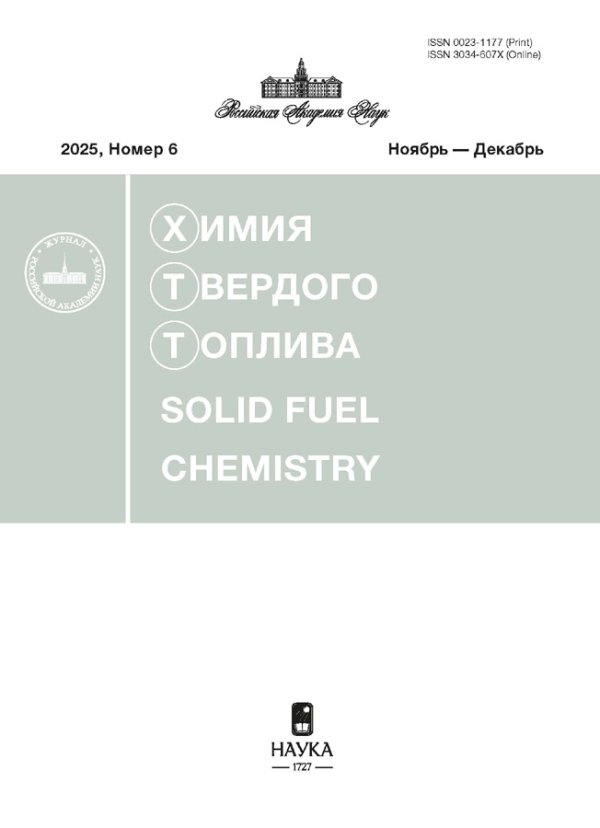ИЗУЧЕНИЕ ТЕРМИЧЕСКОЙ СТАБИЛЬНОСТИ СМОЛ И АСФАЛЬТЕНОВ ТЯЖЕЛЫХ НЕФТЕЙ МЕТОДОМ ТЕРМОГРАВИМЕТРИИ
- Авторы: Певнева Г.С.1, Воронецкая Н.Г.1, Копытов М.А.1
-
Учреждения:
- ФБГУН Институт химии нефти СО РАН (ИХН СО РАН)
- Выпуск: № 2-3 (2023)
- Страницы: 71-77
- Раздел: Статьи
- URL: https://gynecology.orscience.ru/0023-1177/article/view/661896
- DOI: https://doi.org/10.31857/S0023117723020111
- EDN: https://elibrary.ru/BPOFJR
- ID: 661896
Цитировать
Полный текст
Аннотация
Изучена термическая стабильность смол и асфальтенов нафтеновой и метановой тяжелых нефтей методом термогравиметрии. На основе данных физико-химических методов анализа показано, что смолы и асфальтены исследованных нефтей имеют значительные различия по молекулярной массе, элементному составу и распределению атомов углерода в структурных фрагментах. Термогравиметрический анализ проводили при нагреве образцов от 25 до 650°С со скоростью 10°С/мин в среде аргона. Показано, что максимальная скорость потери веса смол и асфальтенов нафтеновой нефти происходит при более низких температурах по сравнению с аналогичными компонентами метановой нефти. Термостабильность смол и асфальтенов зависит от состава и структурной организации этих компонентов, что обусловлено их формированием из нефтяных дисперсных систем различных химических типов. Установлено, что термостабильность смол и асфальтенов метановой нефти выше, чем термостабильность аналогичных компонентов нафтеновой нефти.
Ключевые слова
Об авторах
Г. С. Певнева
ФБГУН Институт химии нефти СО РАН (ИХН СО РАН)
Email: pevneva@ipc.tsc.ru
Россия, 634055, Томск
Н. Г. Воронецкая
ФБГУН Институт химии нефти СО РАН (ИХН СО РАН)
Email: voronetskaya@ipc.tsc.ru
Россия, 634055, Томск
М. А. Копытов
ФБГУН Институт химии нефти СО РАН (ИХН СО РАН)
Автор, ответственный за переписку.
Email: kma@ipc.tsc.ru
Россия, 634055, Томск
Список литературы
- Trejo F., Rana M.S., Ancheyta J. // Catalysis Today. 2010. V. 150. P. 272. https://doi.org/10.1016/j.cattod.2009.07.091
- Varfolomeev M.A., Galukhin A., Nurgaliev D.K., Kok M.V. // Fuel. 2016. № 186. P. 122. https://doi.org/10.1016/j.fuel.2016.08.042
- Корнеев Д.С., Певнева Г.С., Воронецкая Н.Г. // Нефтехимия. 2021. Т. 61. № 2. С. 172. [Korneev D.S., Pevneva G. S., Voronetskaya N.G. // Petroleum Chemistry. 2021. vol. 61. No. 2. P. 152. https://doi.org/10.1134/S0965544121020158]https://doi.org/10.31857/S0028242121020052
- Alcazar-Vara L.A., Buenrostro-Gonzalez E. // J. Thermal Analysis and Calorimetry. 2012. V. 107. № 3. P. 1321. https://doi.org/10.1007/s10973-011-1592-8
- Поконова Ю.В. Химия высокомолекулярных соединений нефти. Л.: Изд-во Ленингр. ун-та, 1980. 172 с.
- Junhui Hao, Yuanjun Che, Yuanyu Tian, Dawei Li, Jinhong Zhang, and Yingyun Qiao // Energy Fuels. 2017. V. 31. P. 1295. https://doi.org/10.1021/acs.energyfuels.6b02598
- Певнева Г.С., Воронецкая Н.Г., Копытов М.А. // Химия в интересах устойчивого развития. 2022. Т. 30. № 4 С. 406. [Pevneva G.S., Voronetskaya N.G., Kopytov M.A. // Chemistry for Sustainable Development. 2022. vol. 30. P. 395. https://doi.org/10.15372/CSD2022396]https://doi.org/10.15372/KhUR2022396
- Patrakov Yu.F., Kamyanov V.F., Fedyaeva O.N. // Fuel. 2005. V. 84. № 2–3. C. 189. https://doi.org/10.1016/j.fuel.2004.08.021
- Иванова Л.В., Сафиева Р.З., Кошелев В.Н. // Вестн. Башкир. ун-та. 2008. Т. 13. № 4. С. 869.
- Alvarez E., Marroquín G., Trejo F., Centeno G., Ancheyta J., Díaz J.A.I. // Fuel. 2011. V. 90. P. 3602. https://doi.org/10.1016/j.fuel.2010.11.046
Дополнительные файлы












